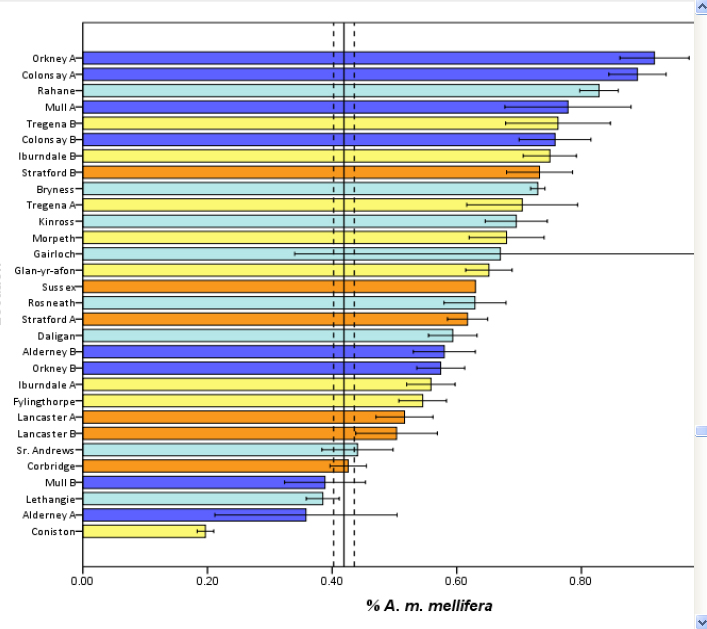- Joined
- Jun 4, 2015
- Messages
- 9,135
- Reaction score
- 15
- Hive Type
- National
- Number of Hives
- 17 nucs....
The E-Cat 'Cold Fusion' Machine springs to mind!
Yeghes da
Why..?..

The E-Cat 'Cold Fusion' Machine springs to mind!
Yeghes da
The B4 ( Bring Back Black Bees) CIC has amassed and collated a lot of data supporting the now well known fact that the UK population of Apis mellifera mellifera was not wiped out during the last century and in fact large pockets remain very much extant in certain areas ( notably Northumberland, highlands and islands of Scotland, Wales and Cornwall and Isle of Man)
a
So why did we import many hundreds of thousands of Amm colonies in the early 1900's ?
And what evidence is there that the Amm types found in the UK today are not simply descendants of those imports ?
Precisely what the research is about... seems that the Cornish Amm is a remnant of the post ice age population.
Speaking to a real expert on this and he said that they were looking into "museum specimens" to evaluate how much introgression had occurred into the extant UK Amm population since the mass importation of exotic non native species |Ca 1860.
I have not seen the Welsh DNA results so I am afraid I can not comment on their parentage!
Yeghes da
It's quite simple to see where the UK and Ireland's Amm come from, there's an Amm family tree in Eigil Holme s bee breeding and genetics.
The Colonsay, Galtea and Northumberland Amm are all identical and come from Brest. Southern Ireland's are identical to Norway. Cornwall didn't apparently have a pure population according to the table. Itll be interesting to see where they come from.

















So why did we import many hundreds of thousands of Amm colonies in the early 1900's ?
And what evidence is there that the Amm types found in the UK today are not simply descendants of those imports ?
Hundreds of thousands?? Source?
I think you might be confused.
This is misinformation, there's the fairly recent Irish work that refutes it, also if you could be bothered to read it the work by Catherine Thompson linked in this thread clearly makes what you just wrote a nonsense.
I know it's winter but try and stay under your bridge.
Precisely what the research is about... seems that the Cornish Amm is a remnant of the post ice age population.
Yeghes da
Any chance you could be more specific on the Thompson study , I've read it before but can't think what you mean.
Last Ice Age started 100 000 years ago and finished 10 000 years ago . Treeles tundra reached to Mediterranean .
Honey bee has no change to live on tundra.
For want for better knowledge

Any chance you could be more specific on the Thompson study , I've read it before but can't think what you mean.

Not sure if this is what he was referring to but it's her graph of Ammness with bees from different areas....Nothing is totally pure. No attempt was made to distinguish French Amms from English Amms, (a lot of French Amms went to the highlands after IofW) she was looking at introgression markers.

A pie chart is a circle divided into slices to give a visual representation of percentages.
The dordogne in France remained temperate and it's thought that's where bees survived and spread from to repopulate north western Europe post the last ice age. Cornwall does exist in a lovely pocket of otherworldlyness though, so who knows?
The dordogne in France remained temperate and it's thought that's where bees survived and spread from to repopulate north western Europe post the last ice age. Cornwall does exist in a lovely pocket of otherworldlyness though, so who knows?
Think you need to read some up to date literature on where they re-populated from after the ice age.
I suggest for starters "THE ORIGIN OF WEST EUROPEAN SUBSPECIES OF HONEYBEES (APIS MELLIFERA): NEW INSIGHTS FROM MICROSATELLITE AND MITOCHONDRIAL DATA"
https://onlinelibrary.wiley.com/doi/abs/10.1111/j.1558-5646.1998.tb01839.x
Evidence points to Asia, not Africa as previously thought.
You need to afford speakers who are little more clued up.but probably followed mans rout to Cornwall and other parts of the British Isles from AFRICA!
Enter your email address to join: